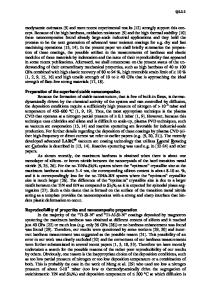Mechanical properties and enhancement mechanisms of titanium-graphene nanocomposites
- PDF / 2,157,311 Bytes
- 11 Pages / 595.276 x 790.866 pts Page_size
- 73 Downloads / 419 Views
RESEARCH PAPER
Mechanical properties and enhancement mechanisms of titanium‑graphene nanocomposites Wanhong Tang1 · Jie Zhang2 · Jianyang Wu3 · Jinyou Shao1 · Peng Ding1 · Guozhen Hou1 · Xiaoming Chen1 Received: 27 February 2020 / Revised: 10 May 2020 / Accepted: 1 June 2020 © The Chinese Society of Theoretical and Applied Mechanics and Springer-Verlag GmbH Germany, part of Springer Nature 2020
Abstract Molecular dynamics (MD) simulations of the titanium-graphene nanocomposites (TiGNCs) under uniaxial tension are carried out to investigate the mechanical properties and reinforcement mechanism of graphene in composites. It is found that introduction of mechanically robust graphene limits the strain-induced dislocation and amorphization and thereby highly improves the mechanical properties of metallic titanium that are greatly affected by the crystal stacking orientation of graphene and titanium layers. The thickness of titanium layers, interface interaction and working temperature play an important role in the mechanical strength and elastic moduli of composites. The results show the mechanical properties of TiGNCs are monotonically enhanced with reduction of the titanium layer thickness and working temperature, and the Young’s modulus obtained by MD simulation are higher than that predicted by the rule of mixture (ROM) due to consideration of interfacial interaction in computational calculation. In addition, once the critical thickness of titanium layer is reached, graphene wrinkles are induced in composites because of Poisson’s effect induced large lateral compression stress in the interface region. This study provides helpful insights into fundamental understanding reinforcing mechanism of graphene and ultimately contribute to the optimal design and performance of mechanically robust graphene-based metallic composites. Keywords Mechanical properties · Enhancement mechanisms · Titanium-graphene composites · Wrinkling · Molecular dynamics
1 Introduction
Wanhong Tang and Jie Zhang contributed equally to this work. * Jianyang Wu [email protected] * Xiaoming Chen [email protected] 1
Micro‑ and Nanotechnology Research Center, State Key Laboratory for Manufacturing Systems Engineering, Xi’an Jiaotong University, Xi’an 710049, China
2
Electronic Materials Research Lab, Key Lab of the Ministry of Education, Xi’an Jiaotong University, Xi’an 710049, China
3
Department of Physics, Jiujiang Research Institute and Research Institute for Biomimetics and Soft Matter, Fujian Provincial Key Laboratory for Soft Functional Materials Research, Xiamen University, Xiamen 361005, China
As the first two-dimensional (2D) atomic crystal, graphene shows extremely excellent electrical, thermal and mechanical properties [1–6]. In order to exert the excellent performance of graphene, finite-sized graphene has been considered as an ideal reinforcement in bulk metal material for forming graphene-reinforced metal-matrix nanocomposites due to its extraordinary properties and high surface-tovolume ratio characteristics
Data Loading...











